Join us for a free one-day workshop for educators at the Japanese American National Museum, hosted by the USC U.S.-China Institute and the National Consortium for Teaching about Asia. This workshop will include a guided tour of the beloved exhibition Common Ground: The Heart of Community, slated to close permanently in January 2025. Following the tour, learn strategies for engaging students in the primary source artifacts, images, and documents found in JANM’s vast collection and discover classroom-ready resources to support teaching and learning about the Japanese American experience.
Cornerstones of a Great Civilization
The Portland Art Museum presents masterworks of ancient Chinese art.
Where

For the past two years, the Museum’s Money Tree has been the subject of intense scientific examination and conservation. This spring, the Museum will celebrate the restoration of this extremely rare bronze sculpture in a special presentation that places it in the context of major cultural developments in ancient China. Crafted in southwest China during the Eastern Han dynasty (25–220), the Money Tree embodies wishes for eternal prosperity in the afterlife. Dragons and phoenixes, symbols of longevity, cavort across the surface of sixteen bronze leaves, each dotted with coin designs. The crown of the tree—previously hidden beneath layers of encrustation, but now revealed by the conservation process—features two monkeys holding bananas, flanking an upright humanoid figure.
The Money Tree is an example of funerary art, an object made expressly for burial, and eloquently expresses the Han-period obsession with the afterlife. In this installation, it will be joined by three other works of outstanding quality that reflect the ideals and values of formative periods in Chinese history. A bronze hu (wine vessel), richly ornamented with incised designs of dragons, birds, and monster masks, was cast in the 13th or 12th century BCE for use in ritual banquets for the ancestors of the Shang royal house. The Shang ruled over northern China at the time, and their ritual bronze vessels were emblems of power and legitimacy. Another bronze work, a ritual bell known as a nao, dating to between the 12th and 10th centuries BCE, illustrates the spread of Shang bronze casting technology to southern China, but its surface designs betray a rejection of Shang authority. The fourth masterwork will be an eerie antlered figure of an Earth Spirit, carved of wood between the 4th and 3rd century BCE and unique to the ancient kingdom of Chu in south central China.
Featured Articles
Please join us for the Grad Mixer! Hosted by USC Annenberg Office of International Affairs, Enjoy food, drink and conversation with fellow students across USC Annenberg. Graduate students from any field are welcome to join, so it is a great opportunity to meet fellow students with IR/foreign policy-related research topics and interests.
RSVP link: https://forms.gle/1zer188RE9dCS6Ho6
Events
Hosted by USC Annenberg Office of International Affairs, enjoy food, drink and conversation with fellow international students.
Join us for an in-person conversation on Thursday, November 7th at 4pm with author David M. Lampton as he discusses his new book, Living U.S.-China Relations: From Cold War to Cold War. The book examines the history of U.S.-China relations across eight U.S. presidential administrations.




